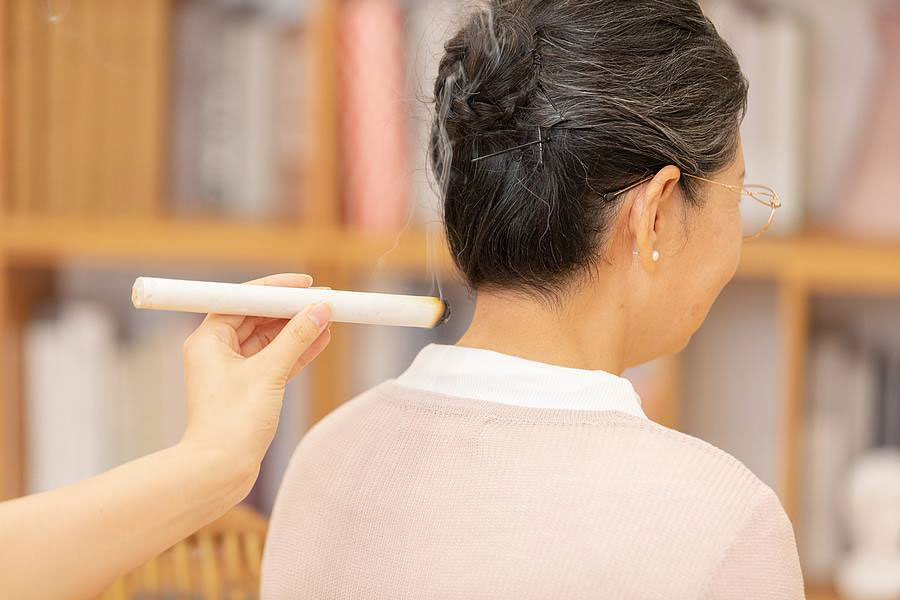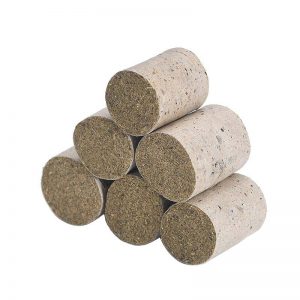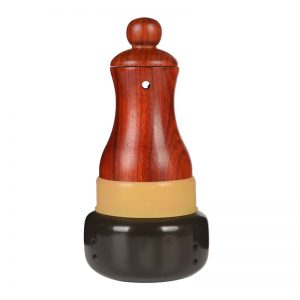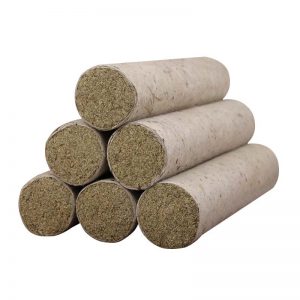Facial paralysis is a nonspecific inflammation of the facial nerve inside the stylomastoid foramen behind the ears. It mainly manifests as a deviated mouth. There are two possible mechanisms, pathology of the facial nerve itself or of its periphery. Pathology of the facial nerve can be caused by wind-cold inducing spasms of the blood vessels that nourish the nerve. This leads to swelling and compression of the nerve. Some believe rheumatic factors or viral infection can also cause facial nerve pathology, such as in Ramsay Hunt syndrome, which is caused by the herpes zoster virus. The second possible cause of facial paralysis, pathology of the region of the facial nerve includes disorders of blood circulation or compression of the facial nerve by periostitis inside the stylomastoid foramen.
In TCM, facial paralysis falls under deviated eyes and mouth, and sudden facial distortion. The disease can occur due to overwork that damages healthy qi and empties the collaterals. The exterior then becomes insecure and wind-heat or wind-cold can easily invade the facial collaterals to obstruct qi and blood and cause dysfunctions of the channel sinews. These lead to the loss of control over the flesh and sinews, resulting in deviated eyes and mouth.
Clinical manifestations of facial paralysis
- There is often a history of some precipitating event, such as exposure to cold, contraction of a common cold, or exposure to wind.
- The onset is sudden, with unilateral facial numbness and immobility. The patient is unable to smile, frown, expose the teeth or puff out the cheeks. The patient may also have trouble keeping fluids in the mouth, and food gets stuck between the teeth and cheeks on the affected side. The wrinkles of the forehead and nasolabial groove on the affected side often disappear, the eyelids are unable to close, and lacrimation occurs when exposed to wind.
- In a few cases, there can be prodromes several days before onset, such as numbness behind the ear, ear pain, facial discomfort, hypersensitivity to sound, and a reduced sense of taste on the front two-thirds of the tongue on the affected side.
7 Acupuncture points for facial paralysis
The basic therapeutic principles are to dispel wind, unblock the collaterals, and dredge and regulate the channel sinews. For patients with deficient healthy qi, reinforcing qi should be done along with dispelling pathogens. Relevant acupoints are chosen based on the following principles: the taiyang channel sinew controls the upper rim of the eyelid; the channel sinew of the foot yangming stomach channel controls the lower rim of the eyelid; the mouth and cheek are governed mainly by the channel sinews of the hand taiyang, and the hand and foot yangming.
1. TE 17 Acupoint (Yifeng)
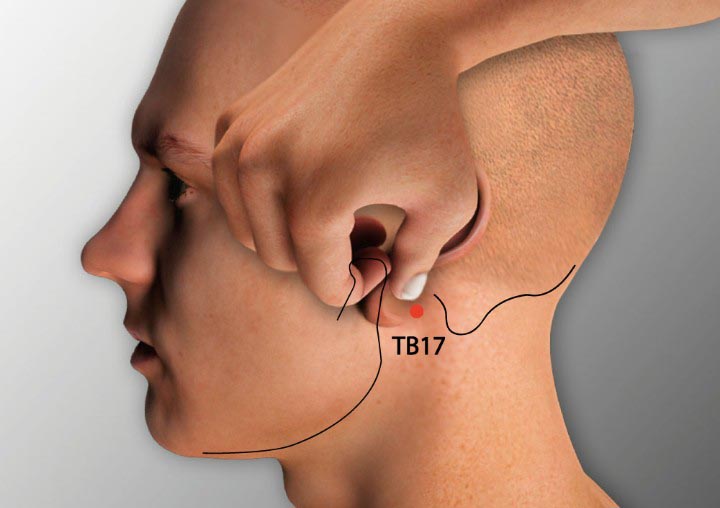
Location: At the base of the ear behind the earlobe, in the depression between the mastoid process and the posterior side of the ramus of the mandible.
Effect: Dispels wind, releases the exterior, treats deviation of the mouth.
2. ST 7 Acupoint (Xiaguan)
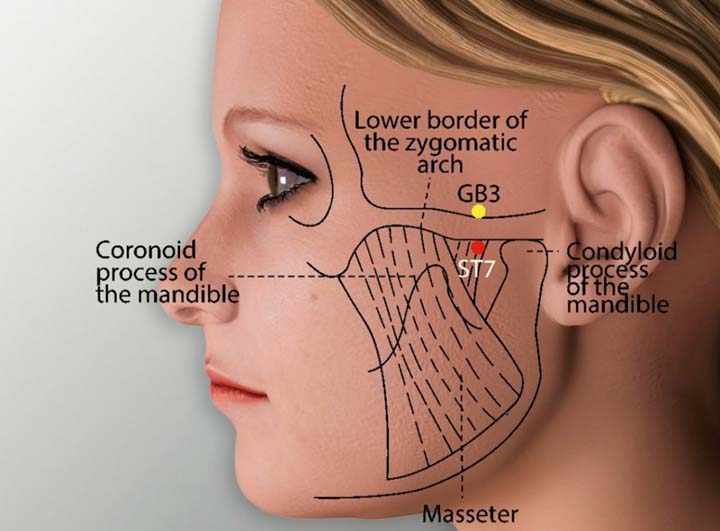
Location: In front of the ear in the depression formed by the zygomatic arch and the mandibular notch.
Effect: Dispels wind, unblocks the collaterals, disinhibits the jaw.
3. ST 6 Acupoint (Jiache)
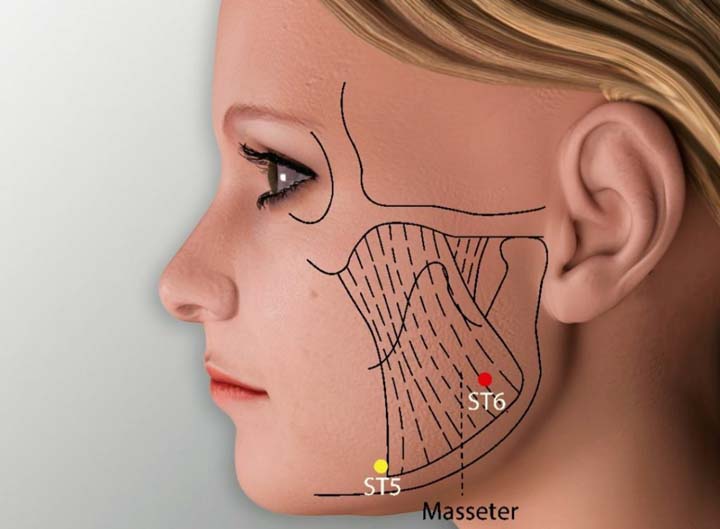
Location: On the prominence of the masseter muscle when the jaw is clenched, in the depression formed when the point is pressed.
Effect: Disinhibits the jaw, dispels wind, unblocks the collaterals.
4. GB 14 Acupoint (Yangbai)
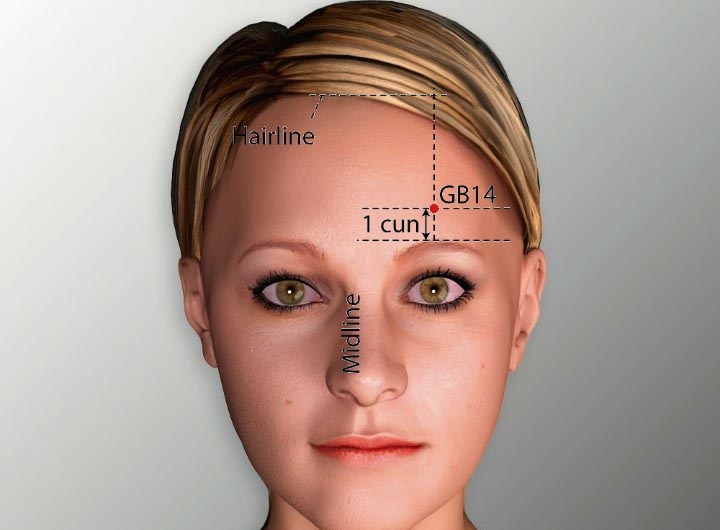
Location: On the forehead directly above the pupil, in the depression 1 cun above the eyebrow, one-third of the way along the line connecting the midpoint of the eyebrow and the frontal hairline.
Effect: Dispels wind, unblocks the collaterals.
5. GV 14 Acupoint (Dazhui)
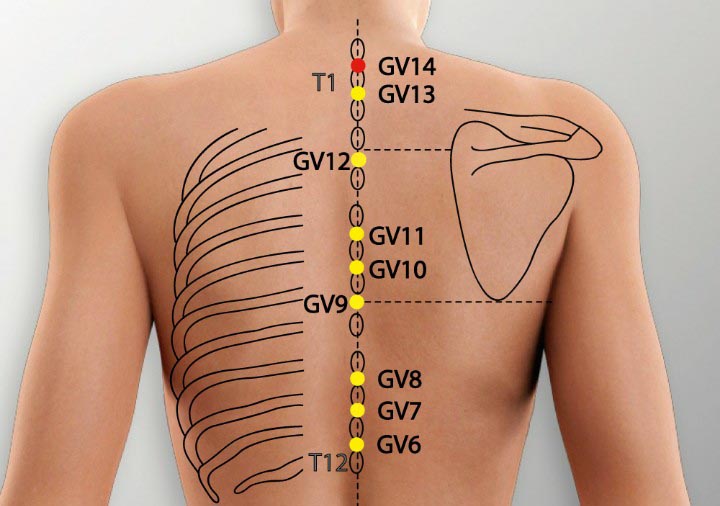
Location: On the posterior midline in the depression under the spinous process of the seventh cervical vertebrae.
Effect: Dispels wind, dissipates cold, releases the exterior, unblocks the collaterals.
6. CV 8 Acupoint (Shenque)
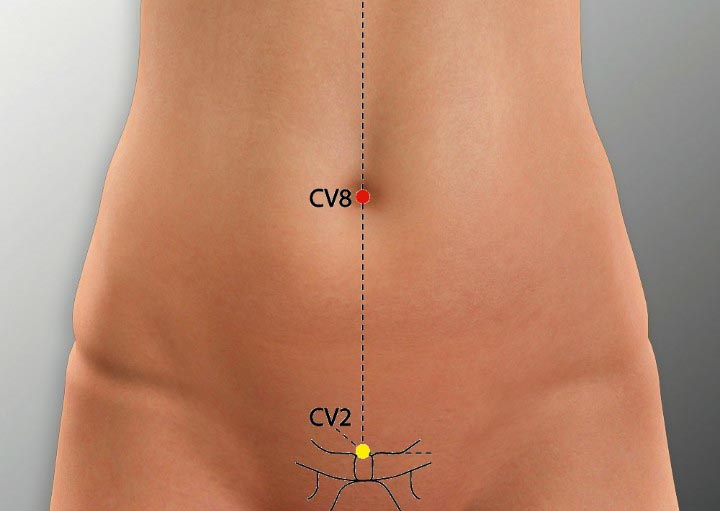
Location: In the center of the umbilicus.
Effect: Supplements original qi.
7. ST 36 Acupoint (Zusanli)
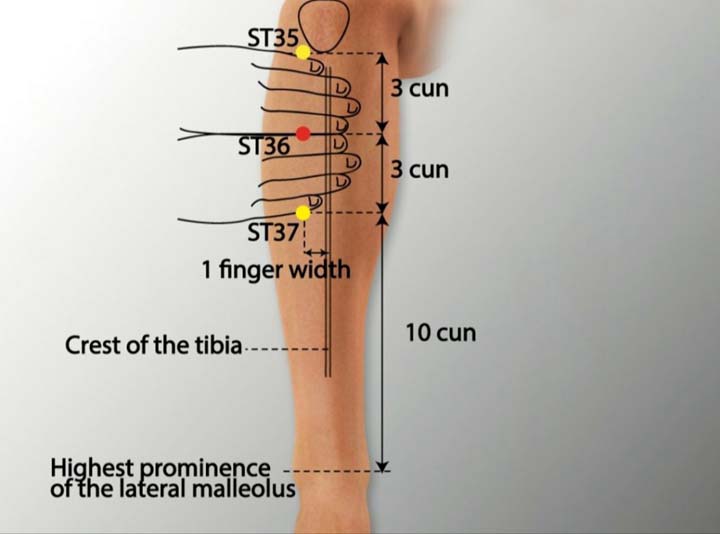
Location: On the anterior-lateral lower leg 3 cun below ST 35, one finger breadth lateral to the anterior border of the tibia, in the tibialis anterior.
Effect: Boosts qi, supplements blood, strengthens the spleen and stomach.
Moxibustion treatment methods
Acute facial paralysis:
- Double-point mild moxibustion on TE 17. The patient should feel the heat penetrate deeply and expand over the affected side of the face. Located on the hand shaoyang san jiao channel, TE 17 can dispel wind, release the exterior and treat deviation of the mouth.
- Single-point mild moxibustion on ST 7. The patient should feel the heat penetrate deeply and expand over the affected side. Located on the foot yangming stomach channel, ST 7 can dispel wind, unblock the collaterals and disinhibit the jaw.
- Single-point mild moxibustion on ST 6. The patient should feel the heat penetrate deeply and expand over the affected side. Located on the foot yangming stomach channel, ST 6 can dispel wind, unblock the collaterals and disinhibit the jaw.
- Single-point mild moxibustion on GB 14. The patient should feel the heat penetrate deeply or expand over the forehead. The patient may also feel local tightness, pressure, soreness or distention. Located on the foot shaoyang gallbladder channel, GB 14 can dispel wind and unblock the collaterals.
- Single-point mild moxibustion on GV 14. The patient should feel heat penetrate, expand over the area, or transmit along the Du Mai or upper limbs. Located on the Du Mai, GV 14 can dispel wind, dissipate cold, release the exterior and unblock the collaterals.
The recovery period of facial paralysis:
- Single-point mild moxibustion on GB 14. The patient should feel the heat penetrate deeply or expand over the forehead. The patient may also feel local tightness, pressure, soreness or distention.
- Single-point mild moxibustion on ST 7. The patient should feel the heat penetrate deeply and expand over the affected side of the face.
- Single-point mild moxibustion on ST 6. The patient should feel the heat penetrate deeply and expand over the affected side of the face.
- Single-point mild moxibustion on CV 8. The patient should feel the heat penetrate deeply or expand along the sides to the waist. Located on the Ren Mai, CV 8 is an important acupoint to supplement the original qi.
- Double-point mild moxibustion on ST 36. In some patients, the heat transmission will reach the abdomen. If it fails to do so, use relaying moxibustion with another moxa stick on the most proximal place the heat has reached to cause it to transmit to the abdomen. Finally, administer mild moxibustion on bilateral ST 36 and the abdomen until the heat-sensitive sensation disappears. ST 36 is the he-sea point of the foot yangming stomach channel, and thus can boost qi, supplement blood, and strengthen the spleen and stomach.
Treat once a day, choosing one or two groups of the above acupoints each time. Ten treatments make a treatment course. Give two or three courses total, with two to five days in between for rest.
Conclusion
In acute facial paralysis, Moxibustion can effectively improve local blood circulation, and promote the elimination and absorption of swelling caused by inflammation of the facial nerve. The earlier treatment is given, the better the therapeutic effect. Moxibustion can also help in the recovery stage.
Patients should avoid wind and cold, and stay away from cold drinks.

